Jose Quintana's numbers are down, but he's still a valuable trade chip
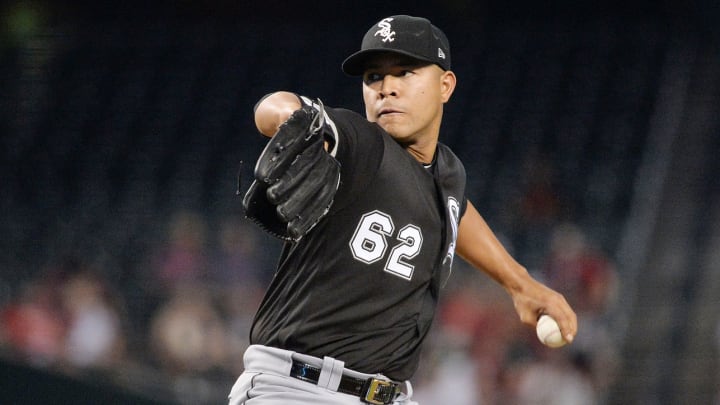
The White Sox tried to compete at the margins for years after their last playoff appearance in 2008, but finally gave in and fully embraced the rebuild ethos last offseason. They were one of the most active teams during the winter, sending out Chris Sale and Adam Eaton, and bringing back a haul of prospects from the Red Sox and Nationals in return. While that will undoubtedly hurt their win-loss bottom line in the short term, the trades were the first two substantive steps toward long-term success.
The team held onto a couple of trade chips so they could be players at the deadline as well. White Sox GM Rick Hahn will certainly field calls on Todd Frazier and David Robertson, but Jose Quintana is his crown jewel. Quintana entered 2017 as one of the steadiest, most underrated pitchers of the last four years. He tossed at least 200 innings every season from 2013 through 2016, never had an ERA worse than 3.51 or WHIP higher than 1.27, and struck out 3.5 times as many batters as he walked. What’s more, he pitched to a 3.20 ERA and 1.16 WHIP with 181 strikeouts in 208 innings in 2016, the best season of his career. It seemed obvious that he would be one of the best, if not the very best, starting pitchers available to contenders at the trade deadline.
Quintana may still be on the market over the next two months, but it’s possible that contenders are reconsidering who to offer for his services. The 28-year-old is in the midst of the worst season of his career. After allowing eight runs in 4 1/3 innings to the Diamondbacks in his last start, Quintana owns a 4.82 ERA and 1.30 WHIP in 61 2/3 innings this season. He does have 60 strikeouts, which has helped him to a FIP that is a full run lower than his ERA, but he has also walked 24 batters. By comparison, he issued 50 walks all last year, and 44 in 2015. On top of that, Quintana is allowing more than one homer per nine innings for the first time in his career.
Heeere's José: How White Sox ace José Quintana became a star, MLB's top trade target
It’s clear that something is up with Quintana this season. Dig around in his peripheral stats for a while, though, and it’s hard to see much difference from previous seasons. His velocity and pitch usage rates are right in line with career norms. His .293 BABIP is neither an outlier nor unsustainable. His hard-hit and line-drive rates are both at would-be career-best marks, should he maintain them all season. The walks, of course, are a problem, and five of the 24 batters who have reached via the free pass have come around to score. Still, walks have never been an issue for him in the past, and we can trust that he’ll correct that in short order.
Hitters are striking out more often against Quintana this year than ever before. They aren’t hitting the ball harder, and they aren’t finding more holes. So what’s going on? Quintana’s ground ball to fly ball ratio is out of whack.
With about one-third of the year in the books, Quintana has a 0.89 GB/FB ratio. Should that hold or only get slightly better, it would be the first time in his career that he allowed more fly balls than grounders. This trend began last year, when his ground-ball rate dipped to a career-low 40.4%, and his fly-ball rate spiked to a career-high 38.7%. Before then, his ground-ball rate had never been lower than 42.5%, and his fly-ball rate hadn’t climbed higher than 37.4%. Quintana may have had the best season of his career with those rates, but it wasn’t likely he’d be able to sustain that type of production with a 1/1 GB/FB ratio, given his skill set.
This year, the problem has only gotten worse. Quintana’s ground-ball rate is down to 38%, while his fly-ball rate has jumped to 42.7%. More fly balls generally equals more home runs, a fact Quintana has learned the hard way the last two seasons.
Quintana surrendered 10 homers in 200 1/3 innings in 2014, and 16 in 206 1/3 frames the following season. In 2016, when his ground-ball and fly-ball rates first started to converge, he allowed 22 homers. This year, he has already seen seven balls fly over the fence. Assuming he throws somewhere between 200 and 208 innings for the fifth straight season, he’s on pace to give up a career-high 23 home runs this year. Fifteen of the 33 earned runs Quintana has allowed have come via the homer.
Jim Bunning: Vexing senator, underappreciated Hall of Famer—but the only man to do both
Here’s the thing, though. Remember earlier when I said that Quintana’s hard-hit rate would be a career-best mark if he could hold it where it is? That shows up across the board. It’s not the quality of fly balls, but rather the abundance, that’s driving his increased home-run rate, which, in turn, is pushing his ERA to never-before-seen levels.
Quintana’s HR/FB ratio is 9.6%. While that would be a new career worst for him, it still grades quite well leaguewide. He has the 22nd-lowest HR/FB ratio among 93 qualified pitchers this season. Last year, when he gave up 22 homers, he had a 9.5% HR/FB ratio. At season’s end, it was the sixth-lowest rate in the league. Quintana isn’t giving up harder-hit or longer fly balls. He’s just giving up more of them. That’s a problem he should be able to correct.
At the risk of simplifying Quintana’s problem too much, this appears to be nothing more than an issue of fastball command. The following zone profiles come to us courtesy of Brooks Baseball, and detail Quintana’s pitch location by season. They are in chronological order, beginning with 2014.
2014
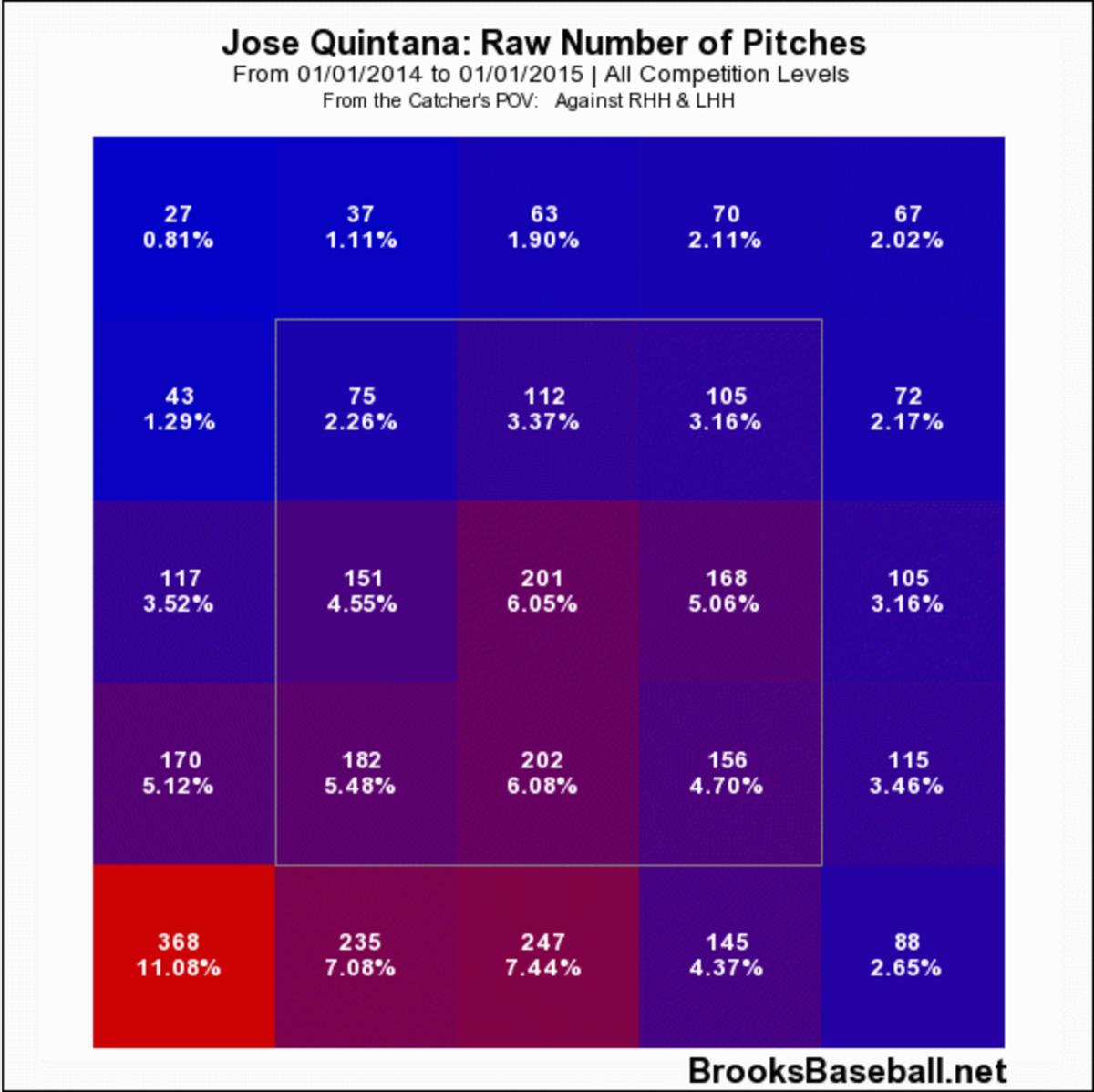
2015
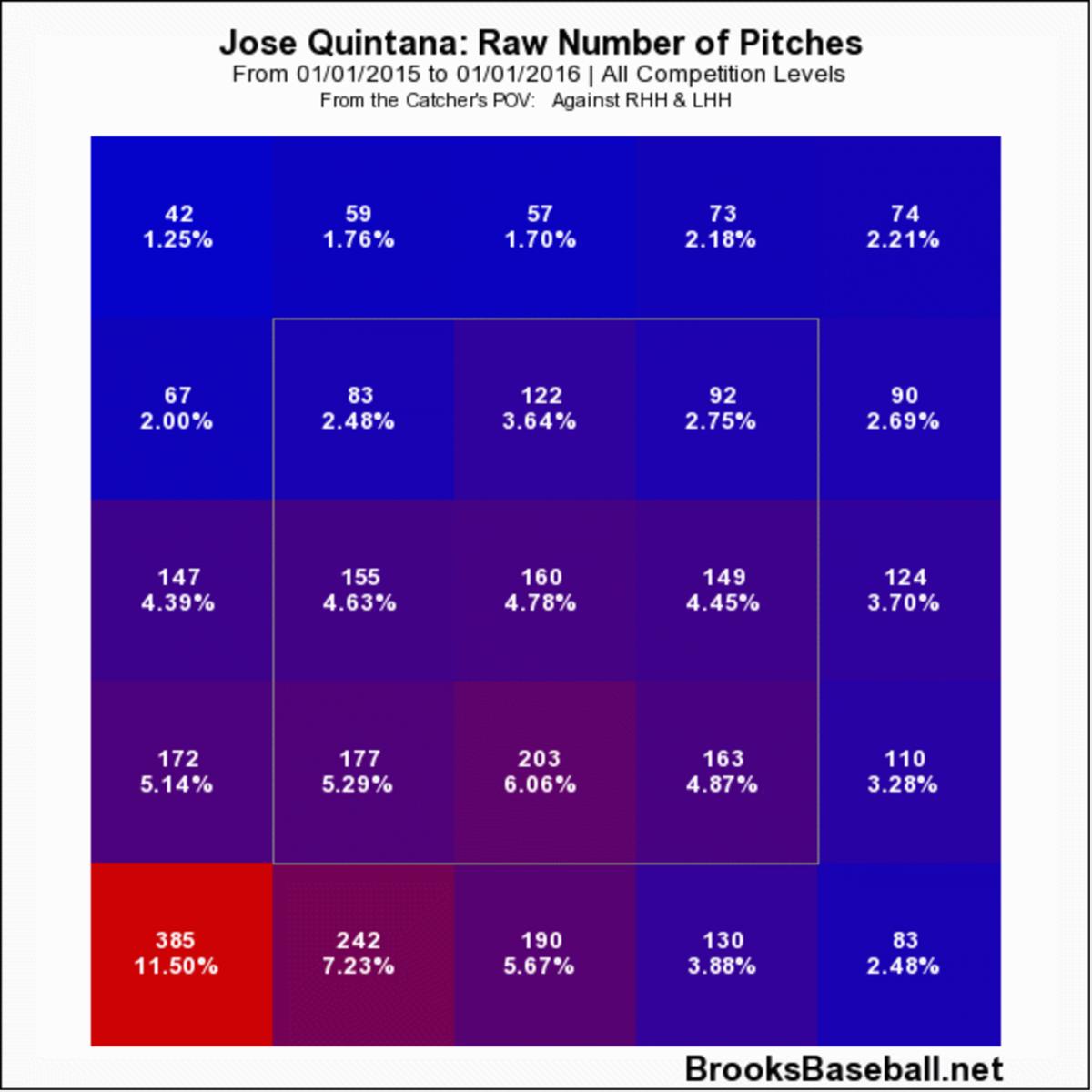
2016
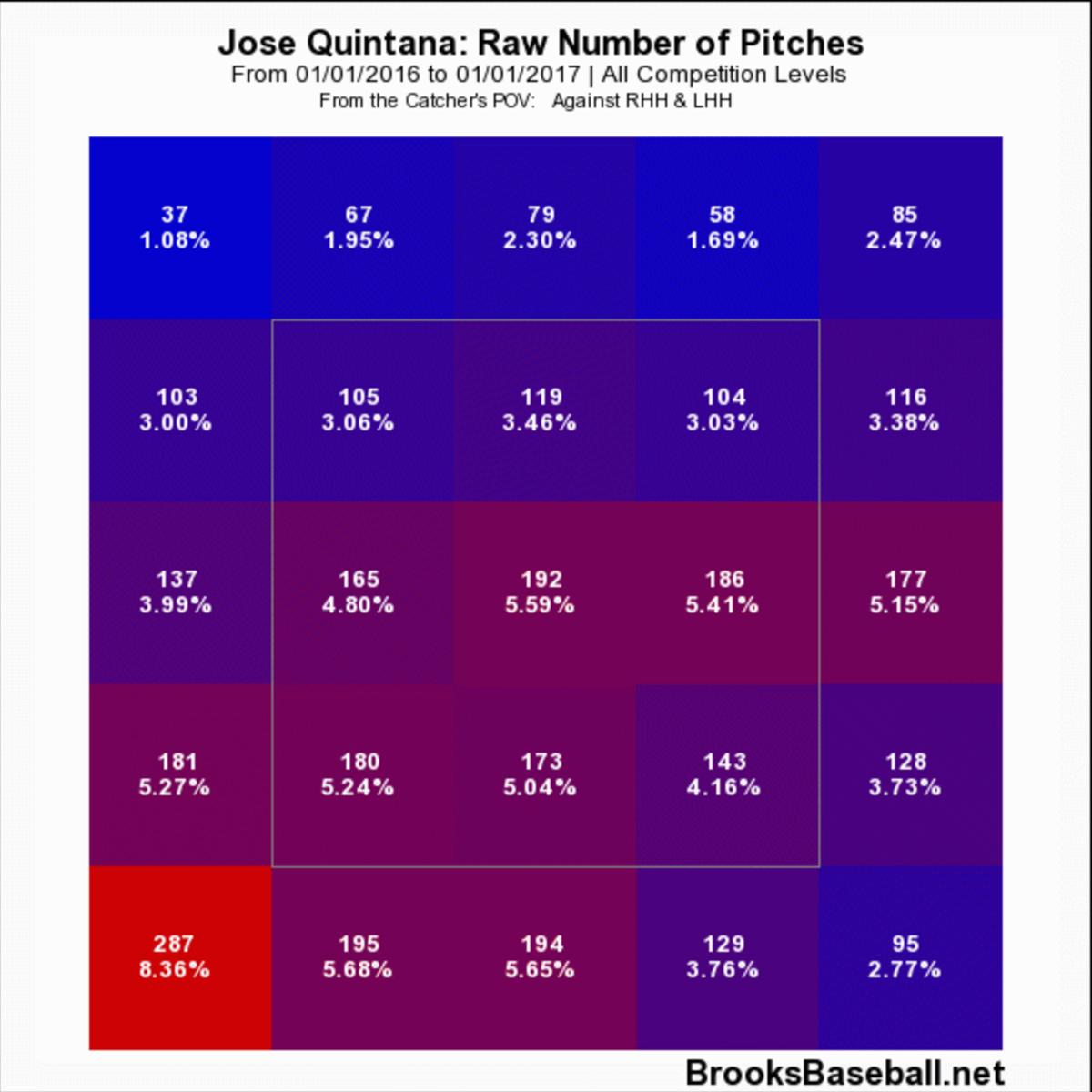
2017
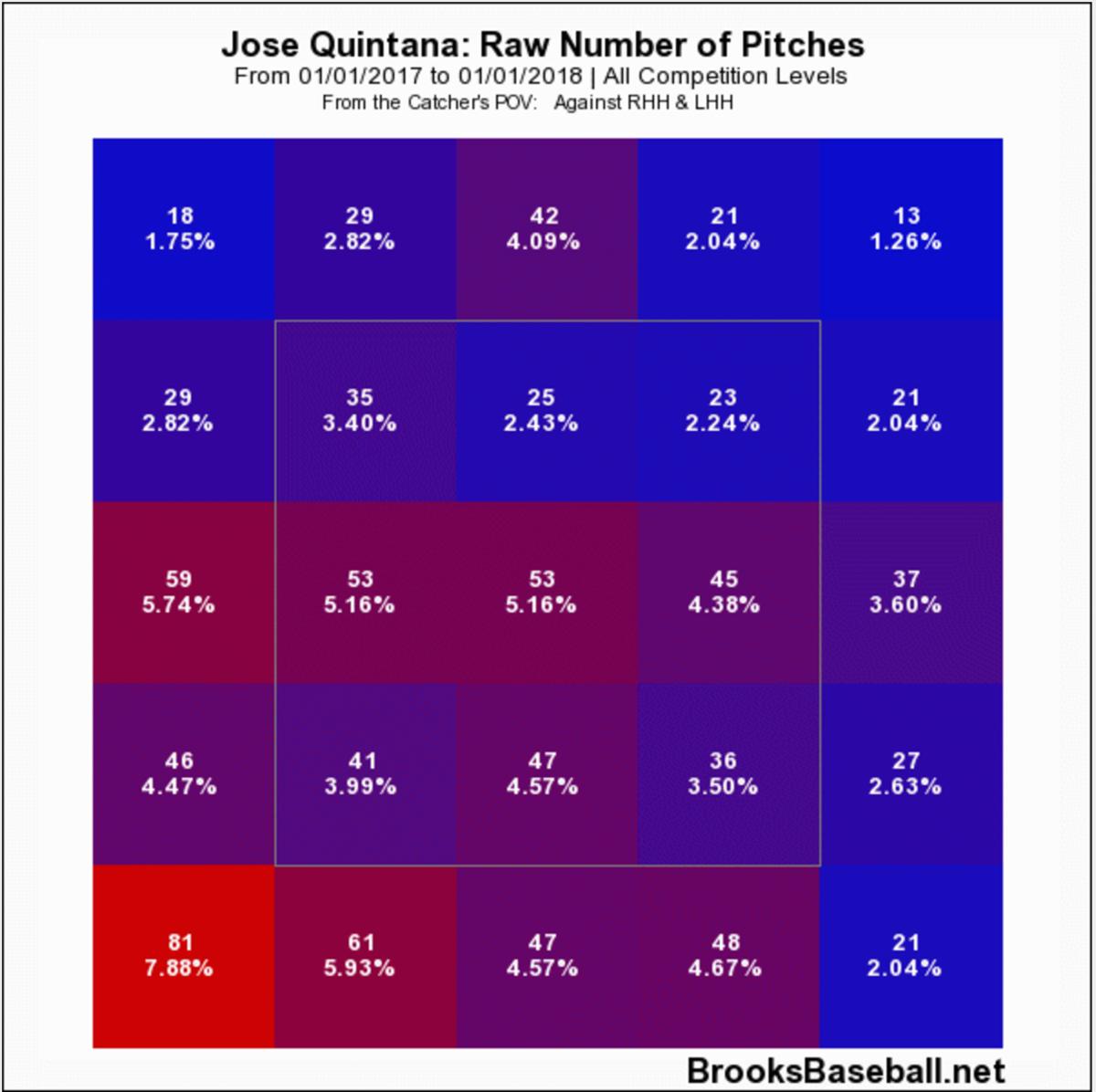
The colors indicate that he has been living up in the zone more frequently with each passing year. The numbers bear that out. Quintana threw 57.5% of his pitches in the lowest two rows, which include the bottom of the strike zone and the areas below the zone, in 2014. That dipped to 55.4% in 2015, 49.7% last year and has hit a nadir of 47.5% this season.
This chart from Brooks measures vertical location. The higher the data point, the higher the pitch was in the strike zone. Here’s what Quintana’s year-by-year average vertical fastball location looks like.
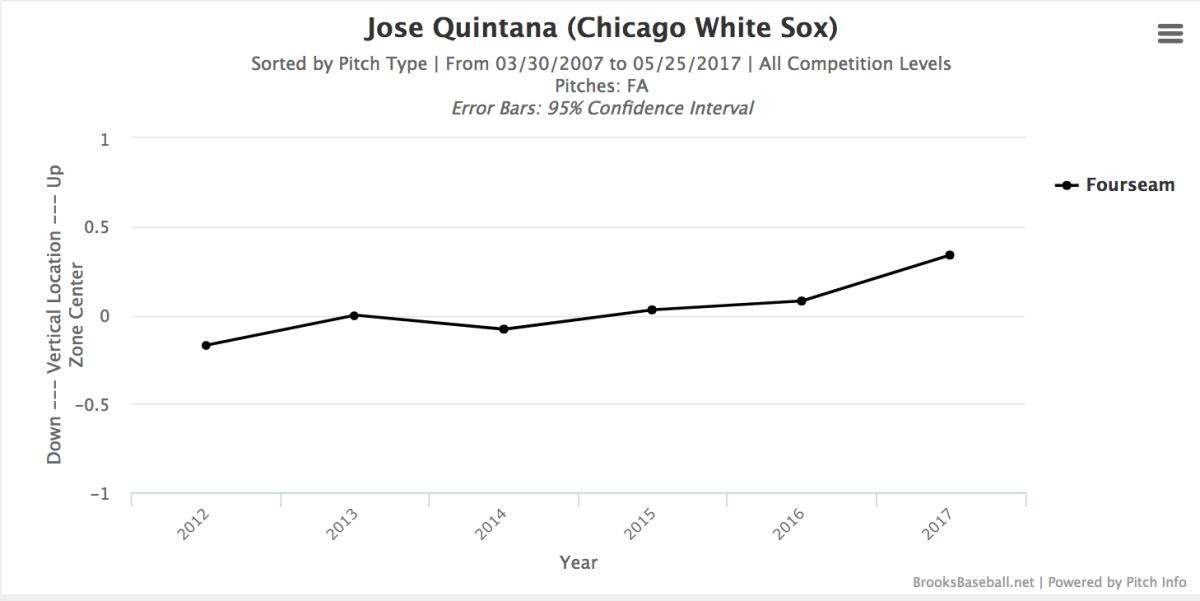
And now, the final piece of the puzzle. Six of the seven homers Quintana has allowed this season have come on the four-seam fastball. This detailed zone profile from Statcast shows the location of those six homers.
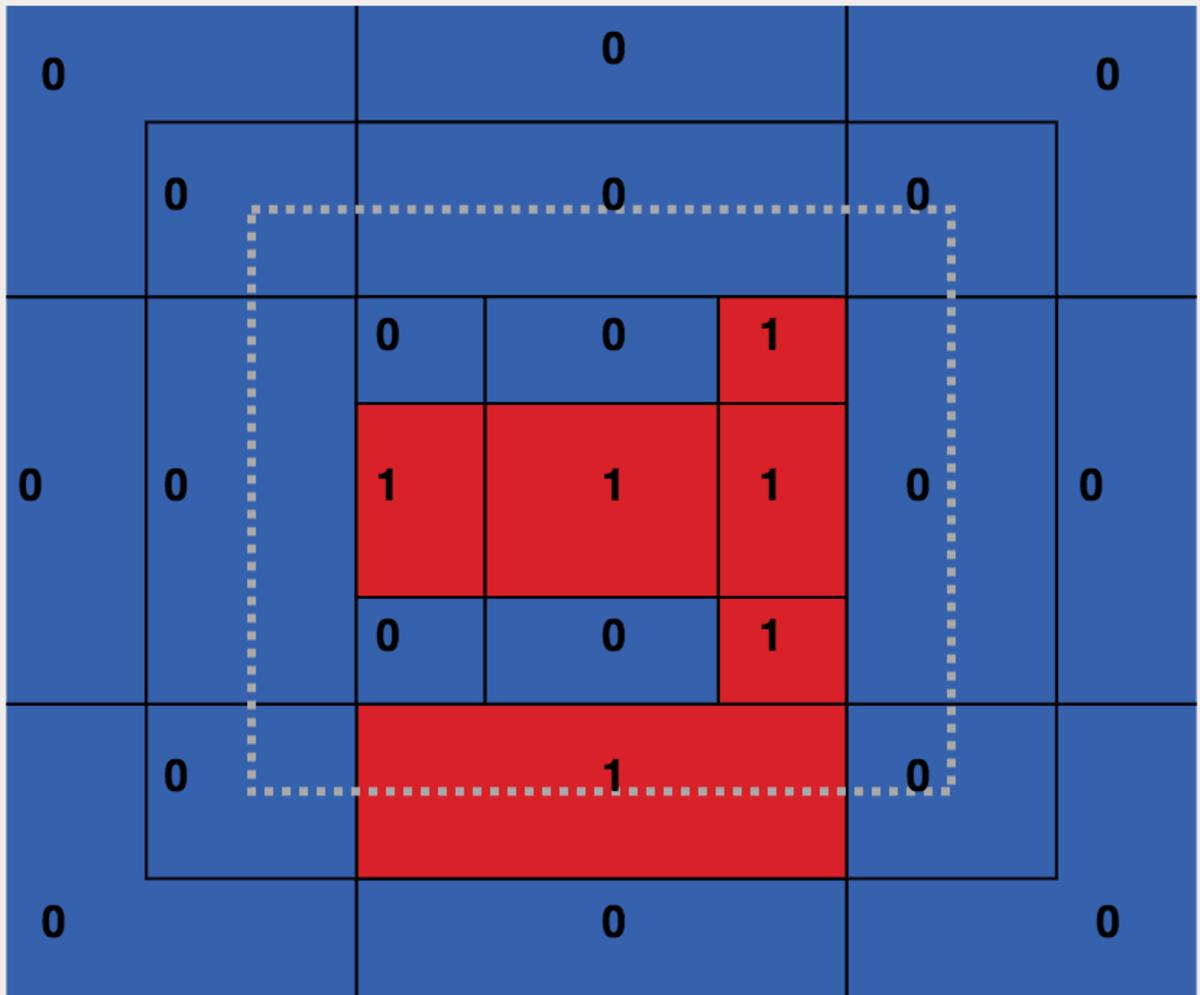
Quintana surrendered six homers on his four-seamer all of last season. He gave up 11 on the pitch in 2015 and four in 2014. He’s nearly one-third of the way to that total, which he amassed in 614 2/3 innings, in 61 2/3 this year. Remember, too, that his velocity hasn’t changed. This is all an issue of command.
More pitches up in the zone for has directly translated into fewer ground balls and more home runs for Quintana. If he can fix that, he can fix everything, and get back to being the most desired pitcher on the trade market this summer.
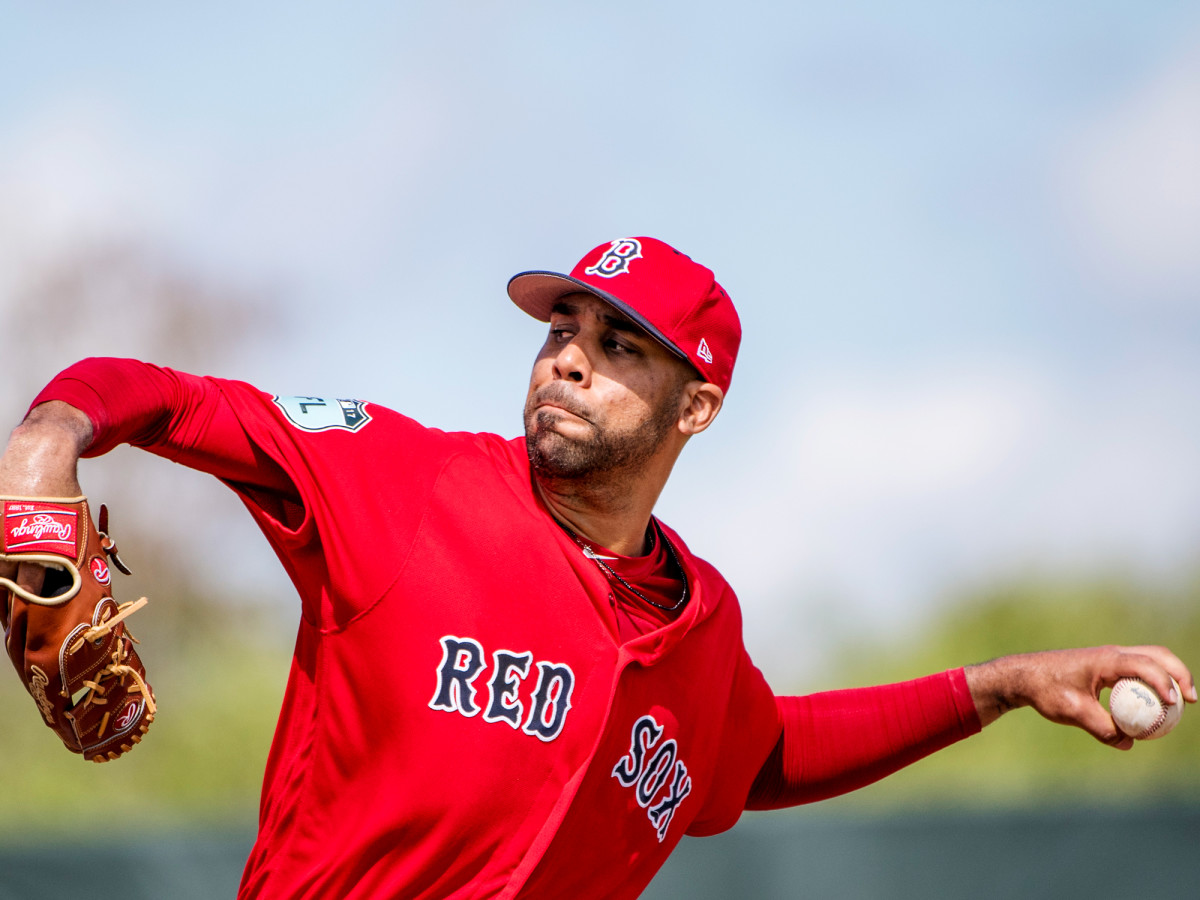
Pitchers to watch this week
David Price, Red Sox
Price has been knocked around in a couple of rehab starts as he continues to work his way back from the elbow issue that has kept him on the DL all season. He has allowed six earned runs on 12 hits in 5 2/3 innings, though he has racked up eight strikeouts. The results, however, don’t really matter. Price hasn’t reported any problems with his elbow, and a clean bill of health will have him back in the Boston rotation in the near future. That could be as soon as this week.
Julio Teheran, Braves
Teheran's inconsistency has been so consistent throughout his career that it’s hard to remember he’s only 26 years old. He has been on the bad side of that dichotomy again this year, pitching to a 4.88 ERA, 5.15 FIP and 1.46 WHIP in 55 1/3 innings. His strikeout rate has also plummeted to 17.1%, while his walk rate has leapt to an alarming 10.2%. That said, he has tossed six shutout innings in two of his last three starts, so there could be reason for optimism. To be fair, however, those outings sandwiched a three-inning, nine-run shellacking at the hands of the Blue Jays. Teheran will take the ball twice this week, facing the Angels on Monday and Reds on Sunday.
Rich Hill, Dodgers
Hill struggled mightily in his last outing, allowing five runs on four hits and seven walks in four innings. His spot in the rotation is safe for now, but that might not be the case for long. Clayton Kershaw, Kenta Maeda, Brandon McCarthy and Alex Wood are clearly locked into the rotation. If and when the Dodgers decide it’s time for Julio Urias to return, Hill would be the odd-man out. Should Hill falter and Urias remain unready for The Show, the Dodgers could also make a move for a starting pitcher before the trade deadline. If Hill doesn’t get it together quickly, he could be out of a starting job. He’s slated to face the Cardinals, the team that walked him to death last week, on Monday, and Brewers on Sunday.
Jose Berrios, Twins
If there were ever a secret on Berrios, it’s out by now. The righty celebrated his 23rd birthday over the weekend after striking out seven Orioles in 6 1/3 innings with some of the filthiest stuff we’ve seen from any pitcher this season. He has made three starts since getting the call from Triple-A Rochester, totaling a 1.66 ERA, 0.84 WHIP and 22 strikeouts against four walks in 21 2/3 innings. The Twins have a bright future, and Berrios is one of the centerpieces. He’ll get a great test against the Astros on Monday, and then take the mound against the Angels in Anaheim on Saturday.
Dylan Bundy, Orioles
Bundy’s disappearing strikeout rate has not precluded him from having success this season. In 64 2/3 innings, he has a 2.92 ERA and 1.14 WHIP, and has notched quality starts in all but one of his 10 outings. That said, it is troubling that he has fanned just 46 batters, with his strikeout rate dipping to 17.9%. He struck out 21.9% of the batters he faced last season, which netted him nearly a strikeout per inning. Even with his sterling rates, his fantasy value will be limited if he can’t rediscover the whiff. Bundy will take a swing at the Orioles top rivals this week, facing the Yankees on Monday and Red Sox on Saturday.
Prospect Watch
Lucas Giolito, White Sox
Giolito entered this season as a consensus top-25 prospect, and was ranked in the top 12 by both MLB.com and Baseball Prospectus. The centerpiece of the deal that sent Adam Eaton to Washington, Giolito has struggled in his first season in the White Sox organization. Through nine starts with Triple-A Charlotte, he has a 5.44 ERA, 1.45 WHI and 43 strikeouts against 25 walks in 46 1/3 innings. He might just have a little momentum after his last start, however.
Giolito tossed a seven-inning no-hitter in Charlotte’s 4–0 win over Syracuse last week. It was the first game of a doubleheader, and minor league doubleheaders feature two seven-inning games. The game may have been 22.2% shorter than a typical one, but it has Giolito closer to the majors than at any point this season.
The White Sox certainly aren’t going to rush Giolito to the majors. He made six appearances, including four starts, with the Nationals last year, though things didn’t go well for him. Couple that with his struggles at Charlotte this season, and it’s likely the White Sox will want him to get on a roll before they consider a promotion. Still, last Thursday’s start could have been the beginning of a run that gets him to the South Side of Chicago.
Two-start Pitchers
Chris Sale
Carlos Carrasco
Kyle Hendricks
Jose Berrios
Luis Severino
Julio Teheran
Robbie Ray
David Price
Kenta Maeda
Marcus Stroman
Dylan Bundy
Rich Hill
Michael Wacha
Chris Tillman
Tanner Roark
Ervin Santana
Matt Moore
Mike Leake
Sonny Gray
Tyler Chatwood
Robert Gsellman
Ariel Miranda
Jordan Montgomery
Brad Peacock
Martin Perez
Daniel Norris
Jeremy Hellickson
Edinson Volquez
Zach Davies
Tyler Anderson
Matt Garza
Jason Hammel
Ricky Nolasco
Trevor Bauer
Justin Nicolino
Jarred Cosart
Alex Meyer
Trevor Williams
Sam Gaviglio
GIF of the Week
Stephen Strasburg had one of the best starts of his career over the weekend, striking out 15 Padres across seven shutout innings. When you have a changeup like this, it’s not hard to miss bats.
